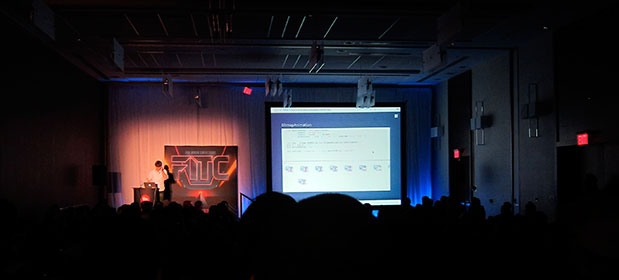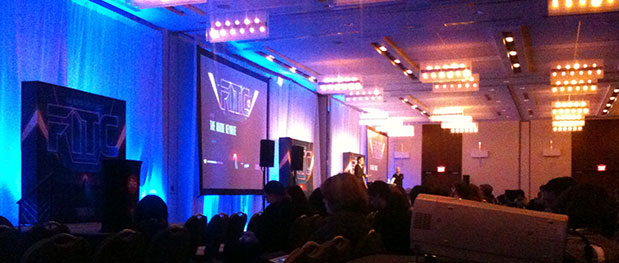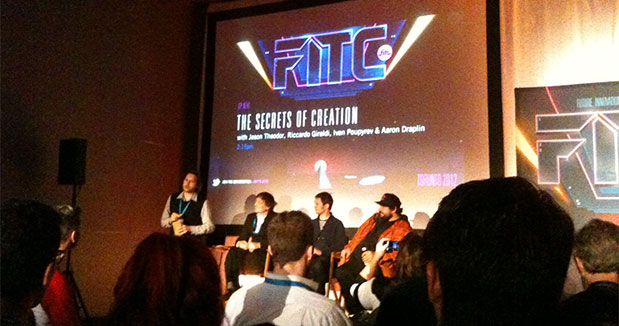FITC. The three day Toronto conference blitz that covers all things new media. The Radii team has had the pleasure of attending the inspirational conference for the last couple of years and we thought we’d share our experience at FTIC 2012 with you.
We’ve all noticed FITC’s fairly dramatic shift from a strong Flash focus to a conference that has very little Flash coverage over the past couple of years. This point is really driven home by the fact that they went so far as to change what FITC stands for; from the Flash specific: Flash In The Can, to the more software neutral: Future Innovation Technology Creativity. Although there wasn’t as much flashy eye candy this year (get it?) there were certainly many interesting and inspiring talks. Below are a few of our favorites.

HTML5 Life in the Trenches - Grant Skinner
This talk was packed, I mean people were standing in the aisles and sitting on the floors (one person even passed out halfway through the talk). The number of attendants wasn’t unexpected though as the exceptional Grant Skinner always draws a big crowd. Grant’s talk at FITC last year left me salivating over the gorgeous animated and interactive Flash pieces he demoed. This year however, he talked exclusively about HTML5 canvas, and more specifically about the CreateJS (http://createjs.com) library he and his team have been putting together over the last few months. CreateJS is a suite of frameworks and applications that make working with HTML5 and canvas easier by abstracting some of canvas’ low level complexities. Though a technical achievement, by the end of Grant’s talk I was longing for some cool visuals, though no such luck.

From Free Software to Fine Art - Evan Roth
Evan Roth is part coder, part artist, and always a big supporter of open source mentality. Evan demoed a number of generative art pieces based off of the motion of graffiti artists’ hands...and eyes. Evan and his team were able to put together a collection of software and hardware that enabled a former graffiti artist and now paraplegic to be able to draw once again using only his eyes. The artist’s tags were then projected in real-time onto the sides of buildings. Similar medical eye tracking software and equipment would have cost thousands of dollars but Evan and his team were able to do it for just hundreds, bringing a very human element to the merits of open source.

The Secrets of Creation - Panel
This panel included Aaron Draplin of Draplin Design Co (http://draplin.com), Riccardo Giraldi of b-reel (http://www.b-reel.com/digital), Ivan Poupyrev a Disney Imagineer and Jason Theodor (http://jasontheodor.com). This panel was a candid look into the minds of some exceptionally creative people. Sources and recommendations for inspiration ranged from looking back (sort of an everything old is new mentality) to simply staring at a wall until inspiration strikes (this was honestly Ivan’s suggestion and as funny as it sounds, I think I’ll definitely be giving this method a try). In general all of the participants of the panel seemed to share one common philosophy, which was to simply do what you love doing and keep doing it, and inspiration will be bound to strike.
Some of the other presentations the Radii team attended were:
- My Adventures in HTML5 Gaming
- The Trouble with JavaScript (and why its worth it)
- I Heard you Like DIVs
- Getting your Feet Wet: The Dive into Processing
- Moving Forward with Flash (or not)
- Responsible Response to Responsive Design
- Object Oriented Electricity in a Social Setting
- How to be a Super CSS Detective
- Designing Motion with CSS3 and JavaScript
- Unstable Condition
- How I Learnt to Stop Worrying and Love Jon Burgerman
Of the 80 or so talks at this year’s FITC, only four were specifically about Flash or Adobe AIR, a pretty remarkable statistic for a conference with very deep roots in Flash and a stat that obviously mimics the industry’s anti-Flash tend lately. The general consensus though seemed to be to simply use the right tool for the job, in some cases that might still be Flash, and in other cases it might not. As designers and developers Flash (or any piece of software for that matter) is simply a tool for us to use, similar to a carpenter’s hammer or saw. We shouldn’t consider ourselves Flash developers or HTML5 designers, instead, we should simply be developers or designers. Don’t let tools define what you do.
